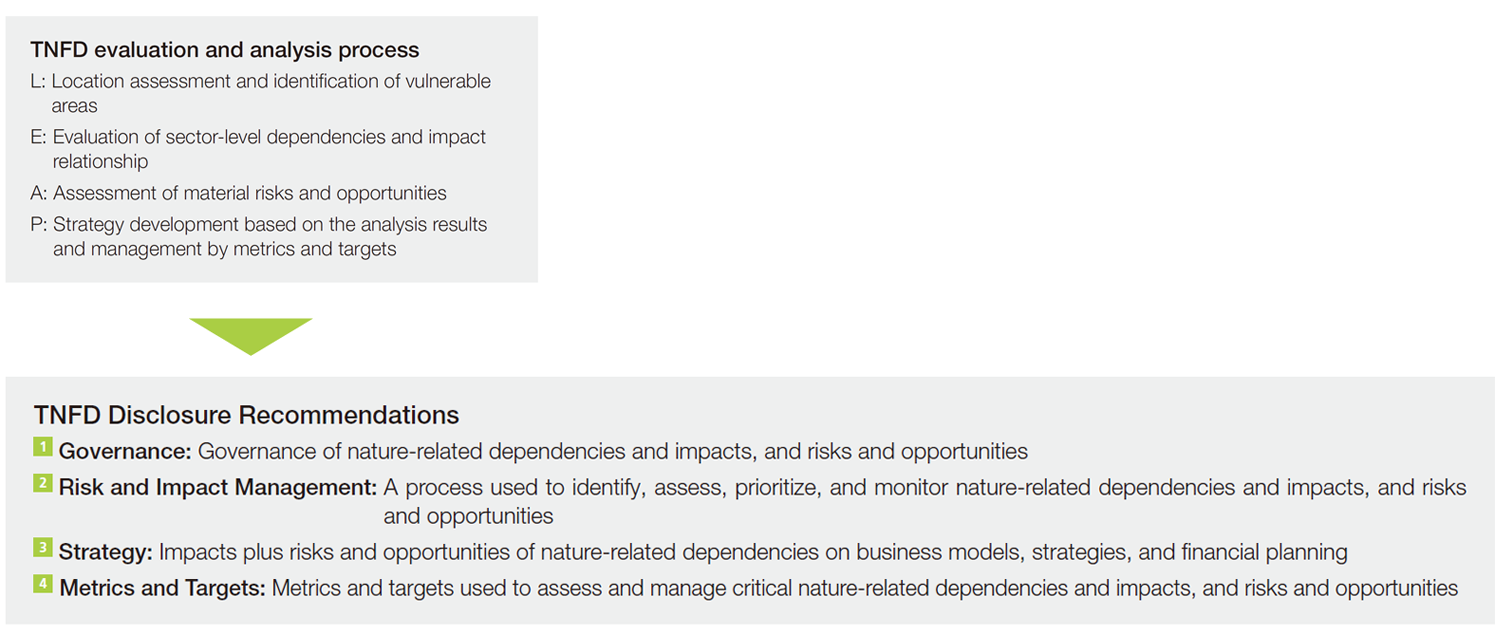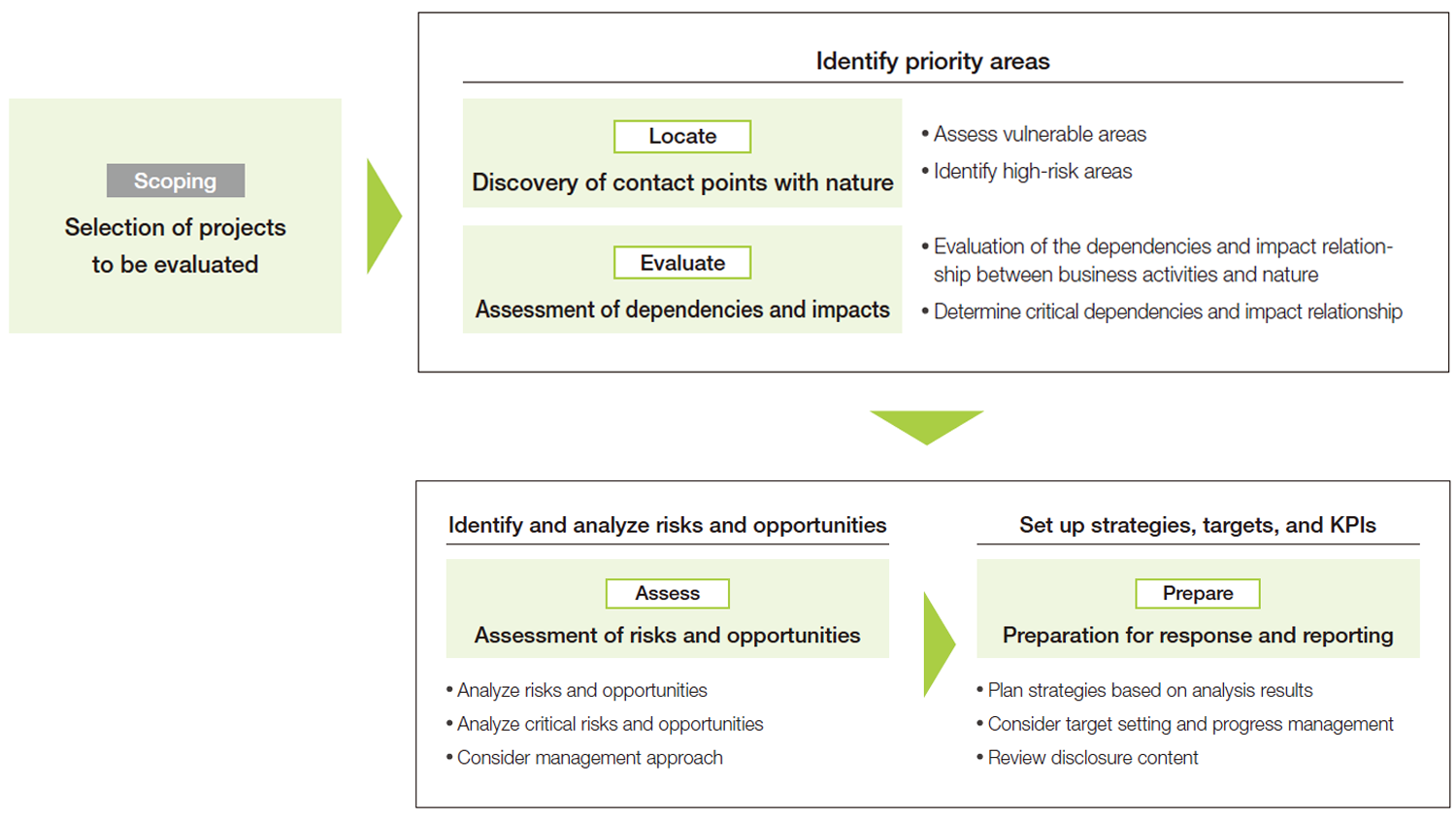Strengthening initiatives for biodiversity conservation and nature positive
Contribution to activities aimed at achieving the 30by30 biodiversity target
In March 2023, we participated in the 30by30 Alliance for Biodiversity to contribute to achieving the 30by30 diversity target the Japanese government strives to achieve, based on the rationale of the Kunming-Montreal Framework adopted at the 15th Conference of the Parties to the Convention on Biological Diversity (COP15) held in December 2022. The alliance is a coalition of volunteers working on the public-and-private sectors to conserve and protect at least 30% of their own country's land and sea areas by 2030 (30 by 30), with the goal of halting and reverse biodiversity loss by 2030 (nature positive).
We aim to have our areas under conserved biodiversity registered as Other Effective area-based Conservation Measures (OECM), including the Creation of Hometown Forests at our steelworks and the Creation of Sea Forests.
In October 2023, the Chita Peninsula Green Belt, which was a collaboration between our Nagoya factory, government, students, experts, NPOs, and 11 other companies, was registered with the OECM.
What is an Other Effective area-based Conservation Measures (OECM)?

Responding to nature-related information disclosure
Today, the state of nature is said to be deteriorating at the fastest pace in human history, raising concerns about the possibility that many of nature’s essential services benefitting society (ecosystem services) may deteriorate. Scientists say that this natural degradation is attributable directly to the pressure on nature caused by human activities, such as changes in how nature is utilized, how resources are exploited, how climate changes and pollution affect the world’s society, and the effects of invasive alien species in the land, freshwater, and oceanic areas.
In as much as we recognize that our core business activities of steel production impact nature, we are engaged in various undertakings to evaluate and analyze the impact of steel production on nature, using various assessment approaches advocated by the TNFD that we reflect in our business activities.
Information disclosure according to recommendations of the Task Force on Nature-related Financial Disclosures (TNFD)
Recognizing that the conservation of biodiversity and restoration of nature (nature-positive) are important environmental issues similar to carbon neutrality and a circular economy, we will strengthen our various measures and consider strategies to reduce nature-related risks and realize opportunities, incorporating them into our business activities.
Disclosure approach in line with the TNFD Final Recommendations
We conducted an evaluation and analysis of the nature-related disclosure recommendations advocated by TNFD, according to the LEAP approach.

1. Governance
The Environmental Policy Planning Committee, chaired by the representative vice president in charge of the environment, reports and discusses environmental policy issues every six months. Issues related to nature-related dependencies and impacts, as well as risks and opportunities, are also reported and discussed by this committee together with other environmental policy issues such as climate change countermeasures and the establishment of a recycling-oriented society. The results are reported and discussed at the Management Committee and the Board of Directors, and are supervised by the Board of Directors.
2. Management of risks and impacts
Concerning dependencies and impacts on nature, as well as our risks and opportunities, we have assessed our direct operation (steelworks) of the core steelmaking business and the mining of iron ore and coking coal in the upstream supply chain, according to the LEAP (Locate, Evaluate, Assess, and Prepare) approach advocated by TNFD. The processes for managing these natural-related risks and impacts are integrated into the company-wide risk management process as described in 1. Governance.

See the process of identifying, assessing, and prioritizing risks and opportunities
(assessment and analysis using the LEAP approach)
https://www.nipponsteel.com/en/csr/env/biodiversity/tnfdassess.pdf
3. Strategy
Using the ENCORE (Exploring Natural Capital Opportunities, Risks, and Exposure) and other tools, we assessed the dependencies and impact relationships of our direct steel operations (steelworks) and upstream supply chains (major raw material suppliers), and assessed and analyzed the nature-related risks and opportunities linked to critical dependencies and impacts from the perspective of their impact on our business models, strategies and financial plans.
Identified as critical risks and opportunities and our strategies to reduce risks https://www.nipponsteel.com/en/csr/env/biodiversity/tnfdstrategy.pdf
4. Metrics and targets
We manage critical dependencies and impact, and risks and opportunities, based on the TNFD Core Global Indicators. Concerning water resources and water pollution risks that are assessed as having a critical impact on direct operations, we are implementing initiatives with the targets of “no serious violations of environmental laws and regulations and no environmental accidents” and “high-level stability of the water circulation rate,” reflecting the risk analysts results in 3. Strategy.
[Indicator: TNFD Core Global Indicators for Critical Dependencies and Impact]
| No. | Driver of nature change | Indicator | Nippon Steel’s disclosure (Direct operation: Steelworks) |
|---|---|---|---|
| C2.1 | Pollution/pollution removal | Wastewater discharged | Volume of water discharged by destination(m3) |
| C3.0 | Resource use/replenishment | Water withdrawal and consumption from areas of water scarcity | No manufacturing base located in areas of water scarcity Volume of water withdrawal and consumption(m3) |
[Indicator: TNFD Core Global Indicators for Risks and Opportunities]
| No. | Category | Metric | Nippon Steel’s disclosure (Direct operation: Steelworks) |
|---|---|---|---|
| C7.2 | Risk | Description and value of significant fines/penalties received and litigation action in the year due to the negative nature-related impacts | None |
| C7.3 | Opportunity | Amount of capital expenditure, financing or investment deployed towards nature-related opportunities, by type of opportunity, with reference to a government or regulator green investment taxonomy or third-party industry or NGO taxonomy, where relevant | 1.3 billion yen (costs for beautification and greening of steelworks) |
[Goals and Performance: Objectives and performance to manage critical dependency/impact items, and risks and opportunities]
| Target | Metric | Goal | Progress management method | Results for FY2023 |
|---|---|---|---|---|
| Water pollution | Serious violations of environmental laws and regulations and environmental accidents | Zero | Development of communication and reporting systems, internal audits, and interviews | Zero |
| Water Resources | Water circulation rate | Stable rates at high levels | Internal audits and hearings | The water re-use rate of about 90% |
